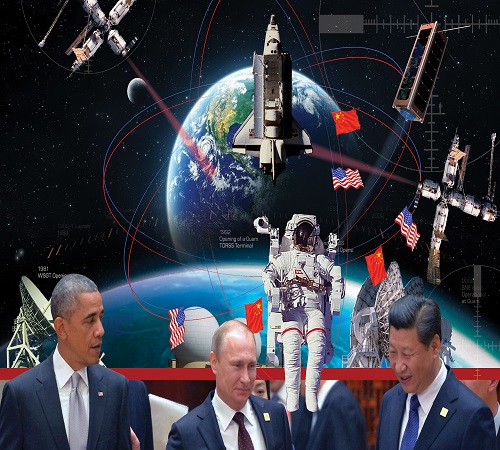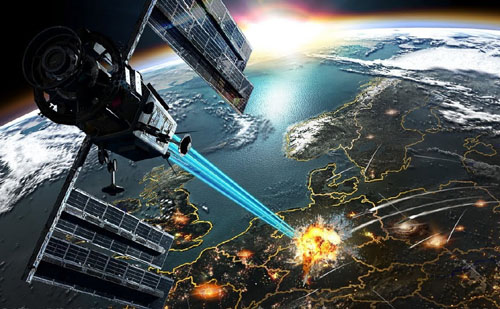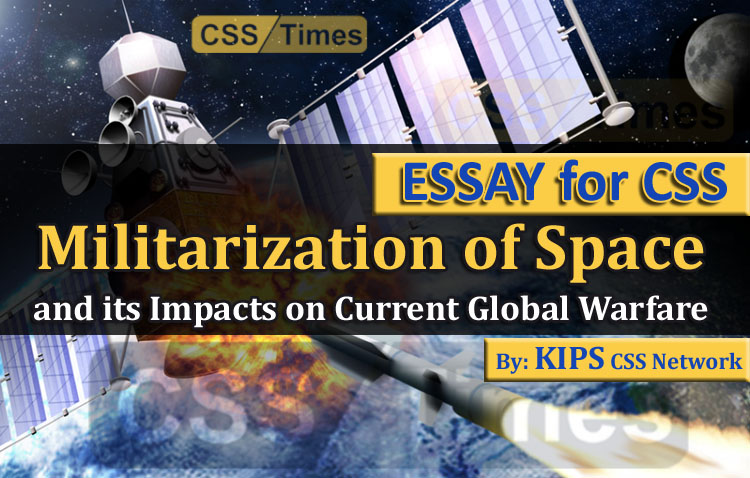CSS Essay on
Militarization of Space and its Impacts on Current Global Warfare
by: KIPS CSS Network
ESSAY OUTLINE: MILITARIZATION OF SPACE AND ITS IMPACTS ON CURRENT GLOBAL WARFARE
World powers, over the decades, have been pursuing dominance in the outer space on pretext of peaceful purposes and for larger good of humanity. Ostensibly, these space programs are projected to reap benefits of weather monitoring, help in research and rescue, for detection of natural disasters, for advancement in science and technology and to deal with space debris. However, this is an open secret that world powers are seeking more military prowess in this erstwhile peaceful arena, this increased militarization of space has brought the modern age warfare to the ultimate high ground and it has profound impacts on economic, strategic and political arenas of modern warfare and is undoubtedly a potential existential threat. Space -a no man’s land- is no more a neutral playground, super power i.e. United States has successfully extended its hegemony and established its dominance in ultimate strategic high ground of space. Other major powers including Russia and China are contesting for their share of power in the space too.
Earth’s orbit wasn’t always such a dangerous place. The Soviet Union destroyed a satellite for the last time in an experiment in 1982. The United States tested its last Cold War anti-satellite missile, launched by a vertically flying F-15 fighter, in 1985. For the next three decades, both countries refrained from deploying weapons in space. The “unofficial moratorium,” put the brakes on the militarization of space. Then in 2002, President George W. Bush withdrew the United States from a treaty with Russia prohibiting the development of antiballistic-missile weapons. The move cleared the way for Bush to deploy interceptor missiles that administration officials claimed would protect the United States from nuclear attack by “rogue” states such as North Korea. But withdrawing from the treaty also undermined the consensus on the strictly peaceful use of space. Five years later, in January 2007, China struck one of its own old satellites with a ground-launched rocket as part of a test of a rudimentary anti-satellite system. This scattered thousands of potentially dangerous pieces of debris across low orbit. Beijing’s anti-satellite test accelerated the militarization of space. The United States, in particular, seized the opportunity to greatly expand its orbital arsenal.

Space has been militarized since the earliest communication satellites were launched. According to estimates, about 1,300 active satellites adorn the globe in a crowded nest of orbits, providing worldwide communications, GPS navigation, weather forecasting and planetary surveillance. Today, militaries all over the world rely on satellites for command and control, communication, monitoring, early warning, and navigation with the Global Positioning System. Therefore, “peaceful uses” of outer space include military uses, even those which are not at all peaceful—such as using satellites to direct bombing raids anywhere around the globe. Quietly and without most people noticing, the world’s leading space powers — the United States, China and Russia — have been deploying new and more sophisticated weaponry in space. Earth’s orbit is looking more and more like the planet’s surface — heavily armed and primed for war. A growing number of “inspection” satellites lurk in orbit, possibly awaiting commands to sneak up on and disable or destroy other satellites. Down on the surface, more and more warships and ground installations pack powerful rockets that, with accurate guidance, could reach into orbit to destroy enemy spacecraft.
United states seek to be the undisputed power in space too. However, China and Russia aggressively seek to challenge U.S. superiority in space with ambitious military space programs of their own, the power struggle risks sparking a conflict that could cripple the entire planet’s space-based infrastructure. And though it might begin in space, such a conflict could easily ignite full-blown war on Earth.
Russia and China are increasingly pursuing the ability to attack America’s space-based assets. Russia’s 2010 military doctrine emphasized space as a crucial component of its defense strategy, and Russia has publicly stated they are researching and developing counterspace capabilities to degrade, disrupt and deny other users of space. Russia’s leaders also openly assert that Russian armed forces have anti-satellite (ASAT) weapons, conduct ASAT research and employ satellite jammers.
The most potent challenge for America in militarization of space comes from china. China, like Russia, has advanced ‘directed energy’ capabilities that could be used to track or blind satellites, and recently, has demonstrated the ability to perform complex maneuvers in space. In November 2015, China conducted its sixth test of a hypersonic strike vehicle, and an anti-satellite (ASAT) weapons in December 2015. There is visible unrest in power corridors of world regarding ASAT test in 2007, which created more than 3,000 pieces of debris, adding significantly to the congested space environment.
However, to challenge U.S strength in this fourth arena of warfare would not be easy. U.S. companies and government agencies have at least 500 satellites — roughly as many as the rest of the world combined. At least 100 of them are primarily military in nature. Most are for communication or surveillance. In other words, they’re oriented downward, toward Earth. Today, the United States has dozens of Aegis-equipped warships carrying hundreds of SM-3 missiles, more than enough to quickly wipe out the approximately 50 satellites apiece that Russia and China keep in low orbit.
This growing competition has profound and lasting impacts on new-age warfare. With weaponizaation of space, star wars is no more just a fiction but is an imminent possibility. In order to analyze the impacts of militarization of space, it is pertinent to dissect the issue in strategic, political and economic domains. Strategic domain being the most relevant has undergone deep refurbishing due to addition of this fourth arena in current warfare. Space-based capabilities like GPS, communications and reconnaissance satellites are inevitable for militaries of 21st century. Militaries on ground depend on these satellites positioned in the space to carry out their operations. So, to hold and maintain a sizeable influence in space arena is inevitable to maintain military power on earth too.
Militarization of space has dragged the concept of balance of power to the fourth arena of warfare. Space capabilities are inextricably woven into the fabric of security, scientific, and economic activities of modern day states. Today, Space assets no longer just tell us where our enemies are and what they are doing; they are integrated with the weapon systems used to target and destroy. Now rival states have to keep an eye on the enemy’s space endeavors too, and being oblivious to this crucial area could later translate into an existential threat for them.
New strengths in space have also exposed new vulnerabilities. Now, states have to protect their satellites as it won’t just affect their dominance in space but also on the earth. Space weapons calls for missile defense system technologies too, in case of any wars in space missile defense system technologies are crucial to protect and maintain a functioning space system. This would further aggravate already soaring weapon race in space. Dual use of satellites is another strategic threat to current warfare as most satellites have potential military application besides the stated peaceful purpose. This calls for ultra vigilant eye on the satellite system of the enemy.
 Militarization of space has deep political impacts on current warfare too. As any mishandled conflict started in space could easily translate into a full blown war on Earth. On the contrary, a mishandled political situation could lead to devastating chain reactions in the most volatile arena of space. Militarization of space would increase expenses based on threat perception rather than concrete intimidation. Rival states would try to outsmart each other in space to gain tactical and strategic edge, which could lead to ungrounded and misguided political decisions. Moreover, politicians would have to convince the taxpayers to spend a huge amount of money on weaponization of space with little short term goals. It would be hard for politicians to convince public on the lingering and potential threat of space wars.
Militarization of space has deep political impacts on current warfare too. As any mishandled conflict started in space could easily translate into a full blown war on Earth. On the contrary, a mishandled political situation could lead to devastating chain reactions in the most volatile arena of space. Militarization of space would increase expenses based on threat perception rather than concrete intimidation. Rival states would try to outsmart each other in space to gain tactical and strategic edge, which could lead to ungrounded and misguided political decisions. Moreover, politicians would have to convince the taxpayers to spend a huge amount of money on weaponization of space with little short term goals. It would be hard for politicians to convince public on the lingering and potential threat of space wars.
In addition to political and strategic impacts militarization of space also has deep economic impacts on current warfare. Growing militarization of space would cajole major powers to spend even more on space programs. A report by the Organization for Economic Cooperation and Development (OECD) states that the United States already spends on space programs – both civilian and defense-related – more than every other country combined. In 2015, the US spent about $40 billion on its space program, while China’s space budget being the second largest in the world, was about $12 billion in 2015; the next, Russia’s, was roughly $8.6 billion; and India’s, the fourth largest, was about $4.3 billion. These budgets are expected to further bulge given the growing arm race in space. Thus, this increased space budget would have a direct impact on already amplified military expenses.
In order to ensure use of space for peaceful purposes, global community has to make concerted and well organized efforts to halt and preferably roll back militarization of space. In order to achieve this coveted goal there is need for global consensus to lay down rules for un-ruled space as the existing and proposed legal instruments legitimize weaponization of space. The existing outer Space Treaty 1967 is insignificant to halt growing militirziation of space as although this treaty ban the placement of weapons of mass destruction in space, it does not prevent states from placing other types of weapons in space. To bridge this gap, Russia and China have proposed Preventing an Arms Race in Outer Space (PAROS), however, it is still under discussion and consensus is not yet reached. In order to reach a global consensus, rival states need to overcome the trust deficit. And to insure a successful and agreed treaty to govern outer space, United Nations should play a proactive role to bring states on a page.
In conclusion it could be safely reiterated that militarization of space has significantly altered the modern warfare and has stretched the warfare to the ultimate strategic high ground of space. Now major powers are competing for enhanced and significant dominance in space to maintain their military might on earth too. This mounting militarization of space has casted adverse effects on strategic, political and economic arena of 21st century warfare. It has significantly altered the space from a pristine place of peace to a volatile court of competition. World community has to join hands to reach a global consensus on peaceful use of space to ensure unabated development in science and technology. World community has to move from competition to cooperation in space to pass on an uncontested space to our next generations.







